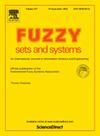An adaptive double-parameter softmin based Takagi-Sugeno-Kang fuzzy system for high-dimensional data
IF 2.7
1区 数学
Q2 COMPUTER SCIENCE, THEORY & METHODS
引用次数: 0
Abstract
Fuzzy or neuro-fuzzy systems have been widely applied across numerous fields. However, they still face significant challenges when addressing high-dimensional problems. This is primarily due to the use of product T-norm, minimum T-norm and its softer variants. In this context, we construct an adaptive double-parameter softmin (ADP-softmin) based Takagi-Sugeno-Kang fuzzy model, called ADPTSK, where ADP-softmin is proposed to overcome the drawbacks of “numeric underflow” and “fake minimum” prevalent in existing fuzzy systems (FSs) when handling high-dimensional data. During the design process of ADP-softmin, we discover that the traditional Gaussian membership function (Gaussian TMF) may lead to ADPTSK FS crash due to its not having a positive infimum, prompting us to give a Gaussian membership function with a positive infimum (Gaussian PIMF). The effective combination of ADP-softmin and Gaussian PIMF enables ADPTSK to handle data with over one hundred thousand features. The ADPTSK is evaluated on 14 classification datasets with feature dimensions ranging from 1,024 to 120,432. The experimental results indicate that ADPTSK exhibits competitive performance in handling high-dimensional problems.
高维数据自适应双参数软算法Takagi-Sugeno-Kang模糊系统
模糊或神经模糊系统已广泛应用于许多领域。然而,在解决高维问题时,它们仍然面临着重大挑战。这主要是由于使用产品t范数,最小t范数及其软变体。在此背景下,我们构建了一个基于自适应双参数softmin (ADP-softmin)的Takagi-Sugeno-Kang模糊模型,称为ADPTSK,其中ADP-softmin被提出以克服现有模糊系统(fs)在处理高维数据时普遍存在的“数值下流”和“假最小值”的缺点。在ADP-softmin的设计过程中,我们发现传统的高斯隶属函数(Gaussian TMF)由于没有正的最小值而可能导致ADPTSK FS崩溃,于是我们给出了一个具有正最小值的高斯隶属函数(Gaussian PIMF)。ADP-softmin和高斯PIMF的有效结合使ADPTSK能够处理超过十万个特征的数据。ADPTSK在14个分类数据集上进行评估,特征维度范围从1024到120,432。实验结果表明,ADPTSK在处理高维问题方面表现出较强的竞争力。
本文章由计算机程序翻译,如有差异,请以英文原文为准。
求助全文
约1分钟内获得全文
求助全文
来源期刊

Fuzzy Sets and Systems
数学-计算机:理论方法
CiteScore
6.50
自引率
17.90%
发文量
321
审稿时长
6.1 months
期刊介绍:
Since its launching in 1978, the journal Fuzzy Sets and Systems has been devoted to the international advancement of the theory and application of fuzzy sets and systems. The theory of fuzzy sets now encompasses a well organized corpus of basic notions including (and not restricted to) aggregation operations, a generalized theory of relations, specific measures of information content, a calculus of fuzzy numbers. Fuzzy sets are also the cornerstone of a non-additive uncertainty theory, namely possibility theory, and of a versatile tool for both linguistic and numerical modeling: fuzzy rule-based systems. Numerous works now combine fuzzy concepts with other scientific disciplines as well as modern technologies.
In mathematics fuzzy sets have triggered new research topics in connection with category theory, topology, algebra, analysis. Fuzzy sets are also part of a recent trend in the study of generalized measures and integrals, and are combined with statistical methods. Furthermore, fuzzy sets have strong logical underpinnings in the tradition of many-valued logics.
 求助内容:
求助内容: 应助结果提醒方式:
应助结果提醒方式:


